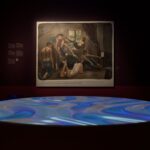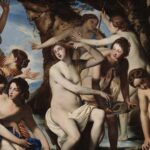Titian‘s Danae is part of the permanent collection of the Capodimonte Museum in Naples.
Danae: the myth
Danae was the daughter of king Acrisio , she was also princess of Argo.
According to the myth that sees her as the protagonist, she would have generated a son who was in turn destined to kill his grandfather, Acrisio. The latter to escape death at the hands of his nephew, locked up his daughter in a tower.
However, Jupiter, transformed into golden rain, reached Danae and from their union Perseus was born This is the story that inspired Titian to create the canvas which, begun in Venice in 1545, was completed in Rome between 1546 and 1547.
The story
The artwork, whose commission was for a long time erroneously attributed to Ottavio Farnese, was ordered by his brother Alessandro.
The identity of the client was confirmed thanks to the discovery of the correspondence of Monsignor Della Casa, papal nuncio in 1544. As further proof, a certain Angela, lover of Alessandro Farnese and famous courtesan of the time, has been recognized in the face of the woman.
But this is only the beginning, the Danae by Titian has a troubled history to say the least: despite the artwork presenting a subject that has been taken up several times in the history of art, so much so that the same Titian will make several versions of it, it was accused of too strong an erotic charge and hit by censorship, relegated to the “Cabinet of obscene things” of Capodimonte.
Then stolen by the Nazis, it was found in a mine in Salzburg and brought back to Naples only in 1947.

Click here and discover the Danae and all the other artworks in the Capodimonte Museum!
The style
Titian paints the Danae taking various artworks as a model.
Certainly the Leda of Michelangeloand Night, also by Merisi, but also Correggio’s Danae, Giorgione’s Venus of Dresden, and his own Venus of Urbino.
However, there is one technical element that sets Titian’s Danae apart from all other masterpieces, or rather it is the absence of this element that makes it almost unique: it lacks drawing .
Titian did not prepare any sketch under the paint and, to confirm this, it is none other than Michelangelo, who saw the work and was pleasantly impressed – especially in the use of color – but expressed reservations precisely because of the lack of drawing. Today, X-ray studies have proved him right, confirming its absence.
Yet the work does not suffer from this lack, quite the contrary: the broad, soft brushstrokes make this artwork by Titian certainly freer stylistically and less tied to the canons of plasticity of the time and his earlier works.
Danae, lying on a white sheet, she is portrayed looking upwards and her body relaxed. The union with Jupiter is legitimized by a loving feeling, as indicated by the presence of the winged Cupid, a clear reference to classical culture.
Danae’s other versions
As anticipated, Titian has realized several versions of Danae.
The one in Capodimonte is the first from a chronological point of view and, from his draft the artist created at least six more, each with variations to please the different patrons: with the Cupid, with the guardian, with the rain or with lightning, with the little dog or without, with the sheet or without.
Of these versions, today some are in major international museums: the 1553 Danae at the Prado Museum in Madrid, the 1554 Danae on display at the Kunsthistorisches Museum in Vienna, and the Danae, also dating from 1554, is at the Hermitage in St. Petersburg.














